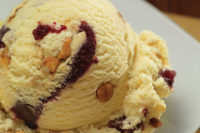The most recent quarterly sales figures from Information Resources Inc., show that dollar sales for the entire milk category were down 3% in the first quarter of this year compared to last. In fact, you have to go back to March of 2002 to find any positive movement in the category in terms of dollar sales. Unit sales have not skidded so badly, having lost just fractions in three of the quarter, and having grown in two. And that tells us there's more to the story. Perhaps the historically low price being paid for raw milk is being reflected at the checkout. Keep in mind that these figures are for food, drug and mass merchandisers, but do not include Wal-Mart, convenience stores, vending or foodservice.
Milk is far and away the largest of the four dairy categories, so the industry continues to work diligently to reverse the negative trends in milk consumption. One of the most successful efforts has been the building of the flavored milk category, which continues to grow at an impressive rate. The total category grew more than 5% by volume in 2002 and without taking into account the convenience channels. The top 10 brands showed a lot of movement, an indication that there is still a lot of opportunity and a reflection of changes that resulted from the 2001 merger of Dean and Suiza.
A look at the top 10 brands of low-fat and skim white milk again reflects some of those changes. It also indicates the rapid growth of organic milk. But total low-fat and skim was down 4.4% by dollar sales for the 52 weeks ended April 20.
Flavored milk is growing nicely, and those dairy companies that are selling single serve milk through vending machines are creating growth opportunities at a higher margin. The industry believes there may be even more potential for growth in foodservice.
Because of this, the Milk Processors Education Program (MilkPEP) conducted a foodservice test at the end of 2002 which showed that simplest marketing efforts could result in significant growth in milk sales. On average, children drank 52% more milk and adults drank 35% more milk when milk was added to menus and servers mentioned milk to diners. More elaborate promotions like flavor straws that add flavor and swirls of color to a glass of white milk resulted in exponential sales growth.
With vending and foodservice channels opening up and with soft drink companies jumping into the dairy- based beverage arena, the overall picture for fluid milk may not be as gloomy as it appears.
